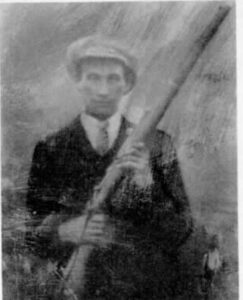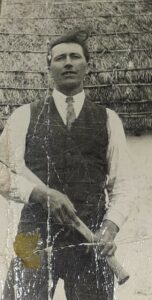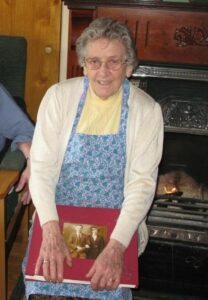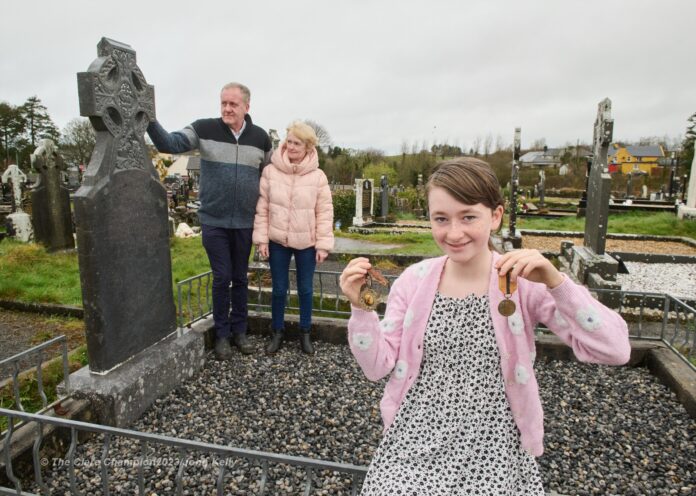Historian Dr Tomás Mac Conmara examines the story of IRA Volunteer Murt Moloney, shot dead by Free State forces 100 years ago this weekend.
‘I was standing with my hands up when a bullet struck me. There were two soldiers standing in front of me, about 9 or 10 yards away’
The final words of Murt Moloney as he was being removed to Ennistymon infirmary, recounted by Dr D.J. Keane, who attended him on that journey. Moloney had been shot by a member of a Free State military unit, who had come to arrest both him and his brother Tomás in the final month of the Irish Civil War. While Dr Keane claimed that Murt did not name his killer, this would be disputed by Murt’s father, who was also by his son’s side and listened with the intensity only such occasions can encourage.

Murt Moloney was born on 12th December 1901 to Martin and Bridget Moloney (nee Clune) in Cloontismara, a small townland in the parish of Inagh. Murt’s brother, known locally as Tomás, was born four years earlier on 9th May 1897. When Murt was just four years of age, his mother Bridget died from Phthisis, a progressive wasting disease, just two months after the death of her 10-month-old daughter, and Murt’s little sister, also named Bridget. Murt’s mother was just thirty years old when she died and left behind a husband, twenty-one years her senior, with five children under the age of eleven. Just three years later, in August 1908, tragedy struck once more when fourteen-year-old Michael, Murt’s older brother, died from consumption.
Having joined the IRA with his brother Tomás in 1917, within two years Murt had elevated to Captain of B (Inagh) Coy. 4th Battalion of the Mid Clare IRA Brigade. Statements from his senior brigade officers, affirm that Murt ‘fought in all ambushes in Battalion area and brigade’. Steve Gallagher, a senior IRA Officer in the Mid Clare Brigade, wrote in September 1933 that Murt was a ‘strict teetotaller and a most active officer, who was always obedient and trustworthy.’ Another high-ranking IRA Officer, John Rynne, characterised Moloney as ‘true soldier’, while IRA Commandant Seamus Hennessy remembered the Inagh republican as ‘a fine character of a young fellow and was one of the best, disciplined courageous Volunteer Officers that I ever met.’ Within the truce period, the Moloney brother’s commitment did not wane and on 30th November 1921, Murt and Tomás were in Kilnamona as part of a two-week Engineers Training Camp, when Eamon De Valera and Dick Mulcahy came to perform an inspection. Within a week, the Anglo-Irish Treaty was signed and the next and final chapter of Murt’s life was opening.

In the Civil War, the Moloneys took a stridently Anti-Treaty position, rejecting the compromise, they felt was at the heart of the agreement. By April 1923, despite an increasing sense that the war was drawing to a close, they remained steadfast in their position. The early days of April had seen significant republican activity within the Inagh area, including the firing on a suspected local spy by the Moloney brothers. During that month, lists of ‘Free State Spies’ were posted around west Clare, detailing the names of twenty-seven men charged with informing for the Free State army. This included four in Inagh, one of whom was likely the individual fired at by the Moloneys. At 2.00pm on Friday 6th of April, three days before Murt’s death, he and Tomás encountered three Free State soldiers between Connolly and Inagh. The brothers, armed with two rifles, held up Private John Corry as well as Privates Halloran and Mooney at a place called Darramore. Although searched at gun point, Corry later testified that they were treated ‘honourably and well’. Tomás wrote later that ‘days afterwards, a party of Free State Officers paid us a surprise visit.’
At approximately 8.00pm on Monday 9th April, Tomás and Murt were on a rare visit with their father at their home in Cloontismara. They had spent long periods ‘on the run’, which meant as Tomás wrote decades later, that ‘poor old father had to cook his own meals and to try and manage as best he could’. Before long, Free State troops broke in the door. Tomás and Martin tried to escape from the back of their house, but it is evident, that both men soon realised there was no escape and stopped to face their enemy. Martin snr. looked in the direction of his sons and saw Murt with his hands in the air, facing the military. Then a shot rang out and his son fell to the ground.
The raid had been led by twenty-five-year-old Tomo Tuohy, a Captain in the Free State army, who had previously been O/C of the Feakle IRA Company. Earlier that day, Tuohy had met with Lieutenant Roche, as well as Privates Foudy and Collins in Ennistymon, who had all been stationed in Lisdoonvarna. One of the men, nineteen-year-old Private Stephen Foudy, knew the road well. In fact, he was a neighbour of the Moloneys, living less than 200 yards from their home. All four recorded that when they arrived at the house in Cloontismara, they saw the two Moloneys running. The all agreed that they pursued them and accepted that both brothers stopped at least once. There was no dispute that the Moloneys were both unarmed. It is at the point where the men recalled shots being fired that stories diverge, considerably.
Tuohy claimed that after calling on Murt to halt on several occasions, he fired in his direction when seeing the latter climbing over a wall. He also, in a somewhat confusing testimony, claimed a shot came over his own head and that he did not know Moloney was shot until he minutes later. When questioned, Private Stephen Foudy testified that he also called on his neighbours to halt before firing once over their heads and ‘two more shots in quick succession’. Foudy claimed not to have seen Murt fall. Given the Free State troops were pursuing just two men running together, it is worth pondering where Foudy was looking, if not in the direction of the Moloney brothers. When pressed, Foudy confessed that he did not know whether he had shot Molony or not. Private Thomas Collins, a native of Corofin, also acknowledged that he fired in the direction that Tuohy was shooting but did not accept that it was he who hit Moloney. Lieutenant Roche too testified to firing in the direction of the Moloneys.
The shots fired by all four Free State soldiers were heard by the neighbours of Murt Moloney.

Just across the field, five-year-old Kitty Keane was playing in her home, lost in her childhood imagination, when she was startled by the sound of gunfire. Moments later, she could sense a panic and fear had entered her townland. In an recording undertaken in 2011, that little girl, then ninety-four-year-old Kitty McGough, recalled with great intensity that moment, some eighty-eight years later:
‘I remember hearing the shot even. Shur ‘twas only across the field. And all of the excitement and all of the rush and I remember a sister of mine, she had been over … I remember her coming running for cotton wool to put to the wound and I can remember that. And shur … ‘twas outside Clune’s door he was shot … his father … his mother was dead when they were young. His brother was Tom or Tomás we called him. He was mixed up in it too.’
The area outside Clune’s door where Murt was shot was known locally as ‘the street’. It was there that Michael Clune saw his neighbour lying in severe pain, with a disconsolate Martin Moloney staring at his wounded son. Kneeling beside Murt was a Free State solider, Thomas Collins, saying an Act of Contrition into one ear, while Tomás was at the other side repeating the prayer. Michael then helped Tomás carry his mortally wounded sibling back to the Moloneys. Tomás was then handcuffed and taken away from his townland, never to see his brother alive again. Writing decades afterwards, he remembered poignantly:
‘I carried my brother badly wounded as he was to my own house, eighty yards away. I was put into the Military car and removed to Ennistymon Barracks, leaving my brother dying after me.’
Murt had been removed in a quilt given to them by Michael Clune’s wife Margaret, who also went to Moloneys. She recalled later that while attending to Murt, he told her he ‘supposed he was going to die’. She recorded how Murt professed that ‘if he had the priest, he was not a bit afraid to die’. Before long, Fr Grace, curate of Ennistymon was by his side, as was Dr Michael Hillery (father of Ireland’s 9th President). It soon became apparent that Murt’s condition was rapidly deteriorating, and a military ambulance came to take him to Ennistymon. Tomás Moloney’s experience over the following twenty-four hours remained embedded deep in his consciousness:
‘He was there all night in the hospital only twenty yards away from me and I wasn’t even brought to see him, he died the next morning at 8 O’clock and I wasn’t even told of it until I was taken out to see him dead at give o clock in the evening. The funeral passed the barrack door next day and I wasn’t even let to see it.’
In the inquest that followed his son’s death, Martin Moloney testified that he saw Murt ‘with his hands up’ and then saw him fall after a shot was fired. After running towards his son, he found Murt lying on his back. In a striking court revelation, Murt’s father told the inquest that his son declared ‘that man Collins shot me’. This was later corroborated by his neighbour Michael Clune, who also recalled that Collins and Foudy were the soldiers closest to Moloney when he was shot. It was recorded that in Cloontismara, Collins had declared; ‘I did not shoot him. It was Foody (sic.) shot him’, a suggestion apparently rejected by Foudy. In his testimony, Dr Keane claimed that, while Murt did not mention Collins by name, he did say of the man who shot him that: ‘Foudy knows him if he likes to tell. He was a fair [haired] man. The shot came from one of the two men that were standing in front of me.’ Carrying the official report, the Dublin Evening Telegraph reported two days later, that Martin and Tom had been ‘wanted for some time’ had tried to escape from the back of the house and were fired upon, which would imply any wound would be in the back.
When examinations were later undertaken of Murt’s body by Dr Keane, it was established, without any doubt that he was shot in the stomach from close range, the bullet having ‘lacerated the intestines in several places.’ Importantly, it was determined that he was shot ‘from the front’, meaning he could not have been shot running away, as claimed by the Free State troops and repeated in the press. Dr Keane clarified the bullet entered Moloney ‘clean’ and was therefore not a ricochet. Keane’s findings were supported by his colleague, Dr Peter O’ Dwyer. The testimony of Murt’s father, that his son was shot while facing the Free State soldiers, ‘with his hands up’, is therefore supported. When cross examined in court, Tomo Tuohy refused on a number of occasions, to address the findings that Murt had been shot from the front, a fact that contradicted his own testimony.
The inquest, deemed a farce by the Moloney family, saw conflicting evidence presented by the four Free State personnel who were present at the raid, in addition to a somewhat bias approach from the bench. For example, a report on Moloney’s funeral, printed in the Irish Independent was discussed, with reference to Moloney’s previous fight against the British considered prejudicial by the Coroner James Lynch. While it was deemed not relevant that Murt had fought against the British, it was insisted that his confronting the Free State was critical to the inquest. When at one point, it was declared that Murt had been ‘in arms against the government’, J.J. Daly, representing the Moloney family, questioned angrily if this was a justification that Murt ‘be shot there and then in the townland of Cloontismara, near his own house’.
Adding further to the confusion, Tomás Moloney, who was flanked by two armed guards. refused to give evidence in the court and is recorded as having said that ‘enough has happened’ and even remarked that ‘it might have been an accident’. The inquest officially recorded that Murt, ‘Died from a bullet wound, inflicted by military’. Leaving a lingering mystery, it also recorded that ‘owing to conflicting evidence, we cannot decide which of the military fired the final shot.’. What is undeniably clear, is that Murt Moloney was unarmed and shot in the stomach from close range. This made it indisputable, that he was facing the man who pulled the trigger, whoever that man was, and offered no danger to the shooter.
Four weeks later, on 5th May 1923, Tomás Moloney was released after signing an undertaking to cease fighting against the Free State, claiming later he was pressurised by ‘two local priests’ into signing. A year later, Tomás was arrested once more by the Civic Guards and military. While the charge against him was not disclosed, he was removed to Dublin and held for a number of weeks before being released. Martin Moloney snr. died on 27th January 1927 at the age of 71, with Tomás by his side. The effect on the family had been great, with their small farm left in severe debt. Reflecting on the experience of the Moloney family many decades later, one former IRA Officer lamented; ‘It is very hard now on Thomas Moloney when he looks back on all the sacrifices that they have made and a national government in power to say that he would not even get his brother’s funeral expenses.’ Such pain within a family is often followed by silence. While always remembered and a source of pride, Murt would not often be spoken of within the family over the decades that followed.
In 2023, a century after his death, North Clare Sinn Féin have organised a fitting commemoration to honour Murt Moloney, ushering his name into a second century of remembering, perhaps distant enough from the raw pain it generated, to allow a deeper focus on the meaning of his sacrifice.


